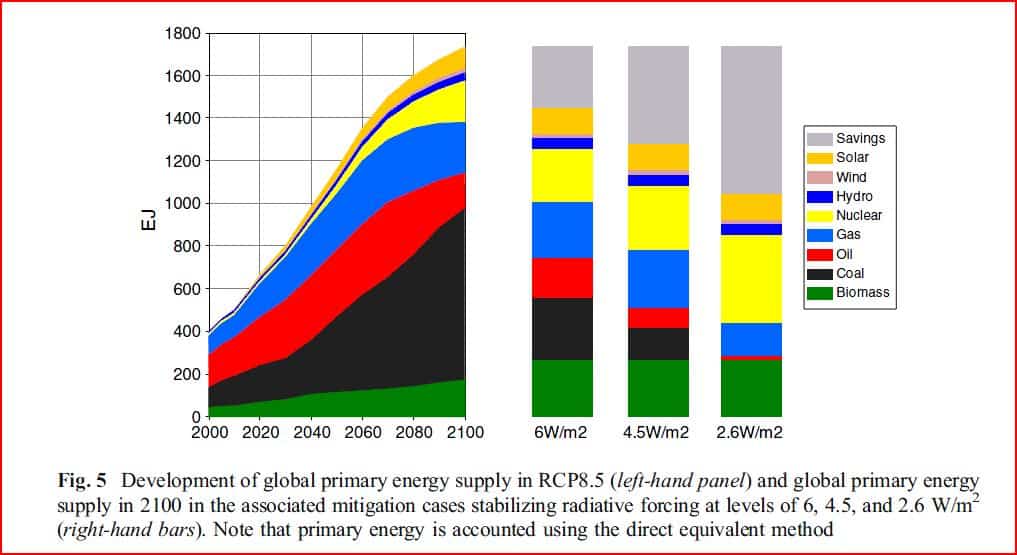Climate Risk, Climate Policy, and the Ukraine Crisis

Photo Credit: Getty
The National Oceanic and Atmospheric Administration’s (NOAA) sea-level rise report made a media splash when the agency released it in February. Headlines in the Washington Post, New York Times, and NBC News all had the same message point—sea levels along U.S. coastlines will rise one foot by 2050. That was a bit of an exaggeration. More importantly, the report implies that achieving President Biden’s goal of NetZero emissions by 2050 would barely affect sea-level rise over the next three decades.
Exaggeration
As can be seen in the chart below, which NOAA describes as “IPCC [Intergovernmental Panel on Climate Change] warming level–based global mean sea level projections,” one foot (0.31 meters) is the upper bound of an estimated range, which has a low end of 0.22m and a best estimate of 0.25m (or 25 centimeters). Moreover, those numbers assume a “socio-economic pathway” called SSP5-8.5. It is a “very high” emission scenario that supposedly drives global average temperatures 5°C above pre-industrial levels by 2100.

SSPs exert the same the warming pressure or “radiative forcing” in the IPCC’s 2022 Sixth Assessment Report (AR6) as the older representative concentration pathways (RCPs) did in the IPCC’s 2013 Fifth Assessment Report (AR5). Radiative forcing is measured in watts per square meter. Both RCP8.5 and SSP5-8.5 assume that, from 2000 to 2100, rising greenhouse gas concentrations boost the natural greenhouse effect by 8.5 W/m.2
Neither scenario is plausible. Both assume coal is the increasingly affordable backstop energy of the global economy throughout the 21s century and beyond. In RCP8.5, for example, global coal consumption increases almost 10-fold from 2000 to 2100. There is no evidence anything like that is happening or will happen. The same governments that joined the Paris Climate Agreement would have to collude to make burning more coal their collective priority.

Global annual emissions projected in SSP5-8.5 for 2050 are more than twice those projected by the International Energy Agency (IEA) in its baseline emission scenarios (called “current policies” and “pledged policies”).

The IEA baselines—at least through mid-century—are close to SSP2-4.5, which projects 3°C of warming by 2100. The SSP2-4.5 best estimate for sea-level rise in 2050 is 21 centimeters—8.2 inches.
Even that may be an overshoot. The IPCC uses a generation of models called CMIP6 to estimate the amount of global warming associated with each SSP. Many CMIP6 models hindcast substantially more warming in the tropics than what has been observed over the past 42 years. The IPCC also uses CMIP6 to estimate sea-level rise from thermal expansion of sea water, and an associated group of models called ISMIP6 to estimate ice losses from Greenland and Antarctica. In SSP2-4.5, for example, thermal expansion and ice sheet losses account for 39 centimeters of sea-level rise by 2100, or roughly 70 percent of the total (AR6, Chapter 9, Table 9.9).
Comparing 38 CMIP6 models with observed warming for the period from 1979 to 2014, University of Guelph economist Ross McKitrick and University of Alabama in Huntsville atmospheric scientist John Christy (2020) found that “every model overpredicts warming in both the lower troposphere and middle troposphere layers, in the tropics, and globally.” Updating the analysis, Christy finds that the CMIP6 model mean trend for 1979-2020 in the upper troposphere (300-200 hPa layer) is +0.41°C per decade compared to an observed trend of +0.17°C per decade. That is the best layer for validating model simulations of the greenhouse effect because it is free of false climate signals from land-use changes.

In short, empirical evidence indicates the CMIP6 models are overly sensitive and predict too much warming—hence also too much sea-level rise—from any given emissions scenario.
Policy Implication
NOAA oceanographer Harold Sweet told the Post that even if the world moves swiftly to curb emissions, the trajectory of sea-level rise “is more or less set over the next 30 years.” Similarly, NOAA Administrator Nick Spinrad told the Times that the projected increase in sea levels will occur “no matter what we do about emissions.’”
Let’s break that down a bit. Here again are the IPCC-based warming and sea-level projections featured in NOAA’s report:

According to the IPCC, limiting global average temperature to 1.5°C above pre-industrial levels would require the entire world to achieve NetZero emissions by 2050 (IPCC, Special Report on Global Warming of 1.5°C, Chapter 2, p. 2). If SSP5-8.5 is the global baseline emission trajectory, achieving global NetZero by 2050 would reduce sea-level rise in 2050 by a mere 7 centimeters or 2.8 inches. If SSP2-4.5 is the baseline, achieving NetZero would reduce sea-level rise by a measly 3 centimeters or 1.1 inches.
Global NetZero by 2050—the Paris Agreement’s “high ambition” emission-reduction target—is infeasible. There are too many nations for which the most urgent energy priority is not reducing emissions but gaining access to electricity and obtaining enough commercial energy to eradicate poverty and support development.
Global NetZero by the 2070s—the Paris Agreement’s basic target—is only slightly less unrealistic. It assumes that industrialized countries like the United States will lead the way and achieve NetZero by 2050. An August 2021 study in Nature estimates that a carbon tax sufficient to achieve a 95 percent reduction in U.S. emissions by 2050 would substantially exceed $1,500 per ton. As statistician Bjorn Lomborg explains in The Wall Street Journal, the tax would cost 11.6 percent of GDP or $4.4 trillion annually in 2050. That “breaks down to $11,300 per person per year, or almost 500 times more than the majority of Americans is willing to pay.”
Bear in mind that U.S. NetZero by 2050 would have even less impact on global sea levels over the next 30 years than global NetZero by 2050, which averts only 1.1 inch of sea-level rise in SSP2-4.5, even when that scenario is run with overly sensitive CMIP6 models.
The good news is that adaptive measures such as sea walls, levees, and drainage systems provide much more protection from sea-level rise at far less cost.
The Current Crisis
Heavy economic losses are not the only risks entailed by the quest for NetZero. An all-climate-all-the-time mindset discourages serious consideration of more pressing and lethal threats.
Hours before Russia invaded Ukraine, U.S. Climate Envoy John Kerry urged world leaders not to let the conflict distract them from combatting climate change. That is backward. The Biden administration’s “whole-of-government” focus on climate change, including the Defense Department’s embrace of the “existential threat” narrative (2021 DOD Climate Risk Analysis), distracts U.S. policy makers from deadlier and more urgent threats, such as war in Europe.
Even a government as big and bloated as ours cannot make everything a top priority. There are always tradeoffs of time, attention, and material resources. Moreover, some policy priorities are profoundly incompatible. Market-driven energy dominance and mandate-driven deep decarbonization are irreconcilable agendas.
A climate-centric focus typically attracts people to government service who know little and care less about great power rivalries and traditional military security risks. Officials committed to the dogma that climate change is the world’s greatest peril are unlikely to be vigilant, resourceful, and tough-minded about foreign adversaries—especially those whom they desire as partners in the “climate fight.”
The administration’s climate-centric focus partly explains why Biden officials did so little to help Ukraine deter Vladimir Putin during the 10 months Russian troops were massing on the country’s border.
The same mindset continues to keep the administration from acknowledging the importance of American energy to U.S. geopolitical influence and to U.S. national security. There is still no plan drive down Putin’s oil revenues by removing all regulatory impediments and risks to U.S. production.
Nor is there a plan to reduce Europe’s dependence on Russian gas by expediting construction of U.S. pipelines and export terminals. Instead, Democrats on the Federal Energy Regulatory Commission recently adopted climate policies that have “thrown the entire process of planning, financing, and applying for a natural gas pipeline certificate or approval for an LNG terminal into disarray.”
For years, climate campaigners have warned that warming-induced floods, extreme weather, and crop failures would create millions of “climate refugees.” About 2 million people have fled Ukraine since February 24. They are not fleeing bad weather, rising seas, or anything else climate-related.
The Russian invasion of Ukraine is what a real “existential threat” looks like. The Biden administration’s climate agenda did nothing to prevent it and does nothing to solve it. If that agenda had any effect at all, it was to make Europe more dependent on Russia for energy, and delay significant U.S. action to counter Russian aggression until after the attack on Ukraine had begun.
(This post was updated on March 11, 2022.)